 Composer: Niels Gade
Composer: Niels Gade
Works: Symphony No. 4 in B flat, Op. 20; Symphony No. 7 in F, Op. 45; Concert Overture No. 3, Op. 14
Performers: Danish National Radio Symphony Orchestra, Christopher Hogwood
Recording: Danish Radio Concert Hall, Copenhagen, Rec 26.2 & 1.3.1997 (Op. 20), 6 & 9.4.2001 (Op. 45), 9-10.4.2001 (Op. 14)
Label: Chandos
Niels Gade, a key figure in the Danish Romantic movement, has often been overshadowed by his contemporaries, yet his symphonic works reveal a rich tapestry of melodic invention and orchestral color. The present recording of Gade’s Fourth and Seventh Symphonies, alongside the Concert Overture No. 3, offers a compelling glimpse into his unique voice. This collection, performed by the Danish National Radio Symphony Orchestra under the baton of Christopher Hogwood, showcases Gade’s ability to blend traditional forms with a distinctly Nordic lyricism.
The Fourth Symphony opens with an Allegro Vivace that, after a brief introduction, takes flight with a buoyant energy. Hogwood’s interpretation captures the vitality of Gade’s orchestration, the swirling strings and robust woodwinds creating a vibrant dialogue. The second subject’s enchanting scoring reveals Hogwood’s delicate touch, although at times, the ensemble’s playing veers towards scrappiness. The slow movement, while imbued with romantic warmth, does raise questions regarding its thematic memorability; yet, its brevity allows for an almost ethereal character that lingers in the listener’s mind. The scherzo, characterized by a featherdown opening, is a standout moment, radiating charm and lightness. However, the finale, with its exuberant swirlings, risks feeling somewhat underdeveloped, indicative of Gade’s tendency to favor brilliance over thematic cohesion. This might resonate as a late-Haydn sensibility, where the weight of the symphony rests on the first movement, and the finale serves more as a celebratory send-off than a thematic resolution.
Turning to the Seventh Symphony, the first movement reveals a warm-heartedness, yet Hogwood’s interpretation lacks the incisive clarity that could elevate the principal theme, rendered somewhat nebulous in its execution. The second and third movements, while possessing moments of lyrical beauty, lack distinctive material, leading to a feeling of protraction. The finale, on the other hand, presents a broader thematic palette; however, it falters in its ability to synthesize these ideas into a cohesive statement. Hogwood’s pacing appears hurried, suggesting that the symphony could have benefitted from more expansive breathing room for its themes to resonate. In contrast, the Järvi recording, while similarly brisk, manages to imbue the work with taut phrasing and a leaner orchestral texture, rendering it strikingly convincing.
The Concert Overture No. 3, receiving its first recording here, stands out with its bardic tone, though Hogwood’s approach may feel slightly over-insistent at times. It is a work that might have thrived under Järvi’s meticulousness, highlighting the nuances within Gade’s orchestration. This recording presents a dilemma for the listener, as it appears that one requires Järvi’s deftness for the Seventh Symphony while Hogwood’s buoyancy shines in the Fourth. Given the differences in orchestral sound and engineering between Chandos and BIS, the preference may hinge on one’s auditory inclinations; BIS’s cleaner sound contrasts with Chandos’s occasionally reverberant, brass-heavy textures.
This Chandos release is a noteworthy addition to Gade’s discography, particularly for its vibrant performance of the Fourth Symphony. While Hogwood’s interpretations offer moments of charm and insight, they occasionally lack the incisive clarity and thematic cohesion found in the recordings of his contemporaries. The challenge remains for listeners to navigate these interpretative choices, ultimately leading to a rich, albeit complex, engagement with Gade’s symphonic oeuvre. The delightful moments in the Fourth Symphony and the bardic essence of the Concert Overture suggest that Gade’s music, with its engaging melodies and orchestral colors, merits further exploration, even if the Seventh Symphony leaves more questions than answers in its wake.



